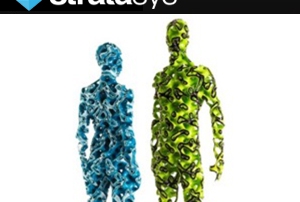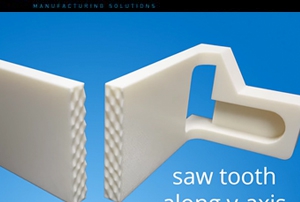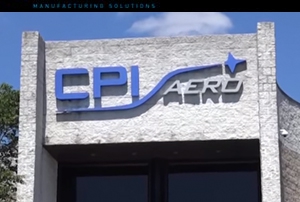Mastercam X9 External Corner Break Radius
In the video below we examine a new option in the Mastercam X9 2D contour cut parameters called External Corner Break Radius. This option eliminates manual deburring of sharp corners, requiring only a simple value entry to generate the break radius. Rather than risk deburring by a manual process or altering the part geometry, External Corner Break gets the job done in a few simple clicks. Watch the video below to see how it works. For more information on Mastercam, please click the button below. More Info
3D Printed Art Collection Explores Futuristic Human Form
Acclaimed artist and designer Daniel Widrig is collaborating with Stratasys to create a futuristic 3D printed art collection. The collection, entitled Descendants, was unveiled at the ‘GLOBALE: Exo-Evolution’ exhibition, which was held at ZKM | Center for Art and Media, Karlsruhe, Germany. DESCENDANTS by Daniel Widrig in collaboration with Stratasys produced using Stratasys’ PolyJet 3D printing technology. Size: 1751 x 452 x 292mm (Female), 1848 x 627 x 342mm (Male). Photo credit: Yoram Reshef Exploring a futuristic context where technological development and computational capacities continue to spiral, Descendants addresses the increasing possibility of superior artificial intelligence and technological singularity, and how future synthetic bodies might look and feel. “With advanced technologies, such as 3D printing, already facilitating the customization and enhancement of the human form, the concepts of a post-human era of non-biological intelligence is now much more conceivable,” explains Widrig. “It is an inevitable yet exciting design challenge to begin to speculate on how new material bodies might be formed to face the real-world constraints of the future.” The elaborate humanoid figures were developed by overlapping high-resolution 3D scans of male and female figures with intricate digital compositions. Bringing the digital images to life, the pieces were 3D printed using Stratasys’ color, [...]
Reverse Engineering Solutions from Cimquest
Cimquest Sales and Scanning Services now offers reverse engineering services and Design X software to our customers and prospects. Whether you prefer to have us scan your part, or if you want to bring that process in house, we are here to help you make that happen. Watch the video above to see how Design X, a premier reverse-engineering software can process data produced by essentially any 3D scanner in existence today. Whether you need to reverse engineer mechanical parts for the production of engineering drawings or you want to be able to print duplicates of your favorite organic shapes, Design X offers a diverse selection of engineering solutions that are truly best in class. Generates history-based CAD models with feature trees. Convert to your preferred file format, including SolidWorks, Creo, NX, Inventor, AutoCAD, CATIA and others. Point cloud, mesh, surface and solid modeling all in one application. Complements your CAD software by creating native models with feature trees – the most popular type of design models. For more information on Cimquest Scanning Services and/or Design X software click the button below, give us your contact info and we will get back to you shortly. Request More Info
In-depth Look at Insight Software From Stratasys
Included with the Fortus Line of Stratasys printers, Insight software gives you more power and customization over your projects. Insight controls the Fortus FDM printers from Stratasys. This includes the Fortus 250 as well as the 380mc, 450mc and 900mc Production Systems. Like Catalyst (the software that controls the uPrint and Dimension line of FDM printers), Insight will run in default mode for easy operation. We call this Green Flagging. However, Insight also has the ability to modify toolpaths which provides better appearance, improved strength and in some cases will speed up the printing process. For example two import functions of Insight are: the ability to fill air gaps and to reinforce features with contours. You can also modify geometry (add or remove) to accommodate for post-printing operations like milling, sanding, and drilling and tapping. This is also great for press-fit applications or where additional clearance is needed. Insight has the ability to mix solid and sparse fill patterns in the same part. The sparse patterns can also be optimized for applications like Thermoform tooling, paper pulp tooling, and more. Once you have come up with your optimal build patterns these parameters can be saved as templates for later re-use. At each layer, the [...]
Customer Spotlight: CPI Aero
CPI Aero is a Cimquest customer that manufactures aircraft assemblies. They started doing military work directly for the government, built a good reputation for themselves, and now they have recently branched off into commercial work. Daniel Gray, their program engineer, explains how 3D printing cut their lead time on most projects from months to hours. They can now take a complicated contour surface from the computer screen and bring it right into their hands in a relatively short timeframe. For some of the tools with very complicated contours (but limited in size) that they can 3D print, they have seen cost savings in the range of 80 - 90% versus quotes from local machine shops. They are using the Stratasys Fortus 360mc and feel that the Insight software that Stsratasys provides is extremely intuitive. Daniel feels that with any CAD experience at all behind you, Insight is very easy to pick up. Daniel explains how working with Cimquest has been seamless for him, from start of contract straight through training of both hardware and software. In only 6 months they have gone from buying things to printing their own. In as many cases as possible they are using 3D printed pieces as less expensive [...]
3D Printed Heart Model Helps Change Little Girl’s Prognosis
Five-year-old Mia Gonzalez has always suffered from breathing issues which limited her ability to function as a normal child. Doctors discovered a rare heart malformation known as double aortic arch. The condition causes restricted airflow due to the entanglement of an extra vascular ring around either the trachea or the esophagus. Often misdiagnosed as asthma, this serious condition requires a complex surgical procedure. Dr. Redmond Burke, Director of Pediatric Cardiovascular Surgery at Nicklaus Children’s Hospital, and his team were faced with a difficult challenge: How could the surgical team separate the double aortic arch without causing additional harm to Mia? The solution was 3D printing. “By making a 3D model of her very complex aortic arch vessels, we were able to further visualize which part of her arch should be divided to achieve the best physiological result,” said Dr. Burke. “It’s very powerful when you show a family ‘this is your baby’s heart and this is how I’m going to repair it.” A happy and healthy five-year-old Mia holds a 3D printed replica of her heart 3D printed by Stratasys, which accurately shows the heart malformation that once caused debilitating symptoms. All too often, surgeons must rely on 2D scans or [...]






